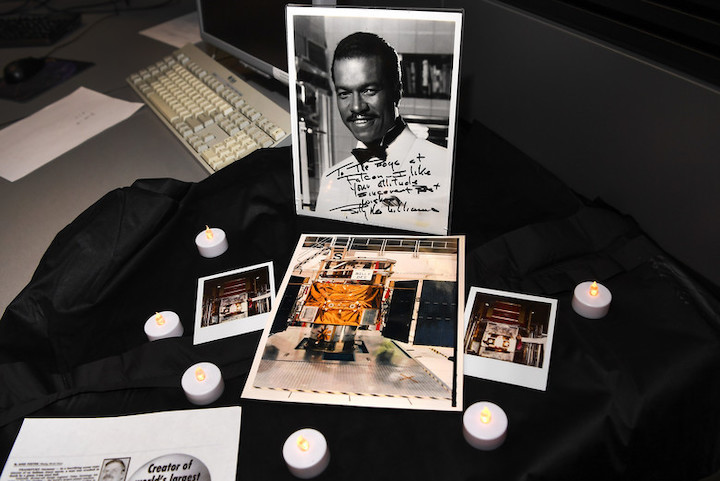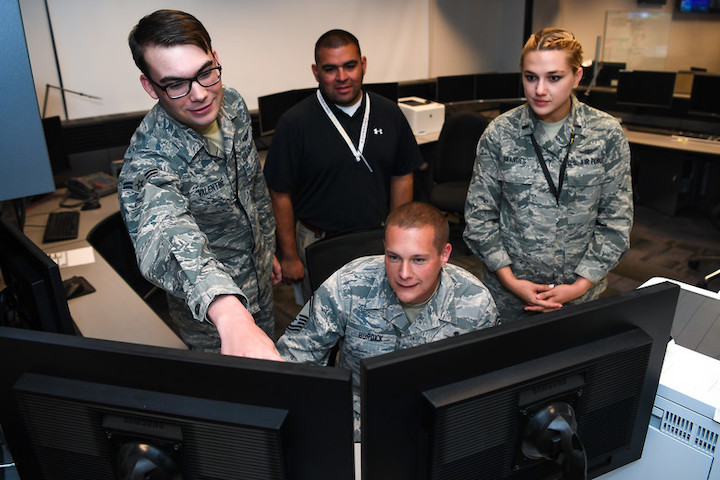19.10.2019

A picture of actor and singer Billy Dee Williams, along with pictures of a satellite named after him, were displayed at the 2nd Space Operations Squadron floor during the decommissioning of one of its satellites on Schriever Air Force Base, Colorado, Oct. 9, 2019. According to Capt. Jeremy Crossman, 2nd SOPS assistant director of operations, the decommissioned satellite was nick named Billy Dee based on a 2nd SOPS internal joke. The word “attitude” in the signed photo is a play on the word altitude, which establishes where the satellite is pointing, a mission critical aspect during a satellite launch. If a satellite’s altitude is incorrect during launch, it could end in a non-operational orbit. (U.S. Air Force photo by Katie Calvert)

Senior Master Sgt. Blair Burdick II, center, 2nd Space Operations Squadron superintendent, gives the last command to decommission Satellite Vehicle Number-38, while Airman 1st Class David Valentine, left, 2nd SOPS satellite system operator; Arturo Martínez, center back, Boeing engineer; and 1st Lt. Kristina Brandes, right, 2nd SOPS chief bus system analyst, observe on Schriever Air Force Base, Colorado, Oct. 9, 2019. The squadron surprised Burdick, who will retire from the Air Force in March 2020, with the opportunity to decommission the 22-year-old satellite from service. This SVN-38 is being decommissioned to make way for GPS-III satellites, the first one was launched on December 2018. (U.S. Air Force photo by Katie Calvert)
CHRIEVER AIR FORCE BASE, Colo. --
The 2nd Space Operations Squadron decommissioned Satellite Vehicle Number 38, to give way to the next generation of GPS III satellites at Schriever Air Force Base, Colorado, Oct. 9, 2019.
First Lieutenant Kristina Brandes, 2nd SOPS chief bus system analyst, said the squadron was disposing of the satellite because it is at the end of its operational life.
“It’s one of our oldest satellites that launched 22 years ago,” she said. “Once we turn off the transmitter (one of the final commands), it will basically be dead in the air...it will be tracked as space debris.”
The satellite will be located at a specific disposal orbit called MEO, or medium earth orbit.
Lt. Col. Michael Schriever, 2nd SOPS director of operations, highlighted the 2nd SOPS Airmen efforts during day-to-day operations.
“We tell [people during] tours, all the time, that the reason our constellation is so healthy is because of the Airmen who control it,” he said. “[There are] a couple decades of experience here across the members who are taking care of these vehicles. Their expertise enables the vehicles to live well past their design life, making sure we can command [and] control it providing the best service to our global users.”
According to 1st Lt. Matthew Triplett, 2nd SOPS executive officer, the squadron decommissions about one satellite per year; the last satellite in June 2017. To date, 2nd SOPS has decommissioned a total of 37 satellites.
The squadron surprised Senior Master Sgt. Blair Burdick II, 2nd SOPS superintendent, who will retire from the Air Force in March 2020, with the opportunity to give the last shut-off command to SVN-38, effectively retiring the satellite.
“It was awesome,” he said. “I was here working in 1st Space Operations Squadron back in 1999 sending commands to SVN-38. That was 20 years ago and on a much older operational system. In March, I am ending my Air Force career and it’s kind of cool to complete this SVN’s Air Force career too. It means a lot.”
Schriever congratulated Burdick on his last official command and for his service in the Air Force and 2nd SOPS.
“That’s a tribute to you too, 20 plus years of service, dedication and commitment to this service,” he said. “2nd SOPS is really appreciative of everything you have done for us. Congratulations, it’s an amazing moment and we appreciate it.”
The SVN-38 is a block II A vehicle which had a design life of 7.5 years. Most of the constellation’s satellites operate well beyond this time, as noted here this satellite lasted 22 years.
Quelle: USAF
